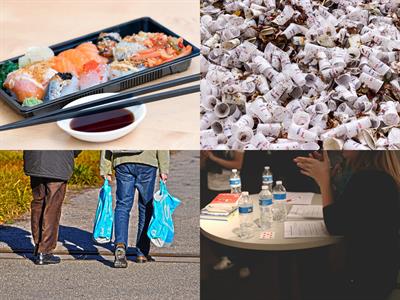PDF chapter test TRY NOW
Toxic effects of plastics: The usage of plastics in our daily lives can be hazardous for two reasons.
- The first reason is that some varieties of plastic carry dangerous compounds to our health.
- The second reason is that many plastics are intended to be used only once. As a result, that could adversely affect the environmental pollution.
(a). Harmful plastics:
Toxic and harmful chemicals are used in three types of plastic. These chemicals are added to plastics to improve their flexibility, strength, colour, fire resistance, and UV resistance.
Example:
PVC (resin code #\(3\)), PS (resin code #\(6\), also known as Thermocol), and PC/ABS (resin code #\(7\)) are the three dangerous plastics.
PVC - Polyvinyl Chloride plastics
- Heavy metals (cadmium & lead) are combined with PVC.
- Phthalates (chemical additives) clone our hormones.
- Igniting PVC releases dioxins (one of the most toxic chemicals known to humans).

PS - Polystyrene plastics
- Styrene is a basic block of this plastic and may induce cancer.
- It takes a very long time (\(100\) - \(1\) million years) to decompose.
- Vast amounts of toxic styrene leak into our food and drinks when they are hot or oily.

Polystyrene plastic example (Termocol)
PC - Polycarbonate plastics
- PC plastic includes Bisphenol A (BPA).
- BPA is emitted by PC products used in the preparation of foods and drinks.
- BPA alters the way our bodies work by increasing or decreasing certain hormones.
ABS - Acrylonitrile Butadiene Styrene
- Styrene is harmful to our eyes, skin, digestive system, and lungs.
- BFRs (Brominated Flame Retardants) are frequently used.
- According to studies, this plastic releases toxic chemicals.
(b) One-time use of plastic
Plastics, both used and thrown away, cause both short- and long-term environmental damage.
Throwaway plastic items account for half of all plastic produced today.
Single time used plastics cause health issues for humans, plants, and animals.
Throwaway plastic items account for half of all plastic produced today.
Single time used plastics cause health issues for humans, plants, and animals.
Example:

Use and throw away or single-time use plastics.
Plastic cups, plates, carry bags, straws, water pouches, plastic sheets and cutlery used for food wrapping.
